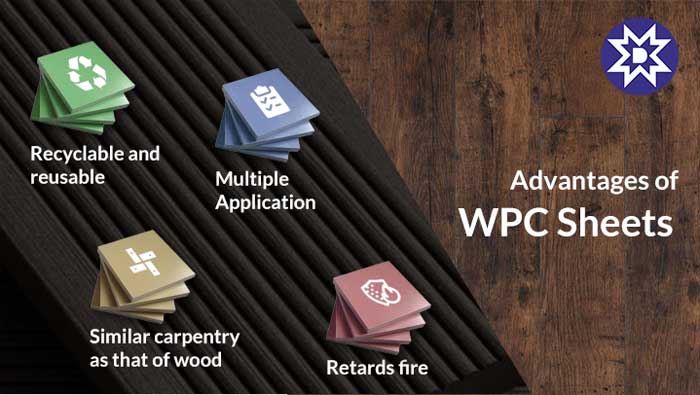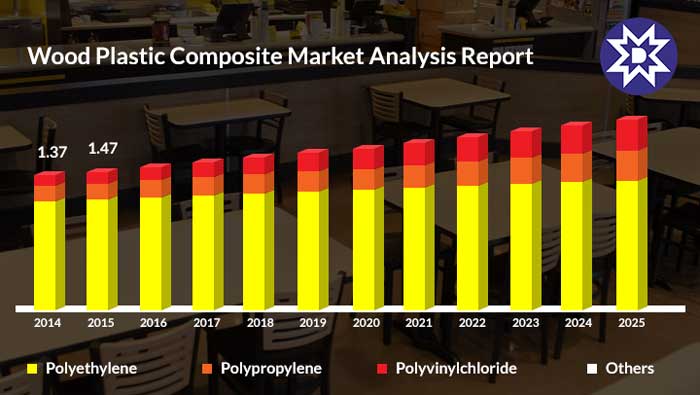Welcome to VANJOIN. Your satisfaction is our biggest pursuit.
Wood Plastic Composite (WPC) is a combination of wood flour powder, sawdust, wood pulp, bamboo, and thermoplastic. Mostly, the plastic used is recycled from substances like polyethene, polyvinyl chloride, and polypropylene. These materials are used in comparison to others which form a small portion. Though the designing and manufacturing is notably indistinguishable from contemporary plastics manufacturing, there are certain considerations required before selection of the material.
The ratio of wood to plastic in the wood plastic composite is critical because it determines its performance when it undergoes production. The melt flow index (MFI) of the resultant product depends on the percentage of wood in the Wood Plastic Composite. The percentage of wood in the final product is inversely proportional to the melt flow index. WPC sheets have the appearance of wood with improved strength, which makes it preferable over conventional wood products.
There are several advantages of wood plastic composite, such as

Recyclable and reusable
WPCs are environment-friendly. Most of it is made from waste products and recycled materials. The components are wood mass, wood waste, agricultural waste, and waste plastics. Though the wood plastic composite itself is long-lasting and withstands external exposure, the components used to make it are biodegradable like rice husk, cotton, coir, and jute, etc. Using WPC prevents cutting of natural wood and its manufacturing also ensures material usage tending to 100% with no waste production. There are carbon dioxide emissions but they can be controlled and unlike wood, it is free from formaldehyde and melamine emissions.
Wood-plastic composites don’t require surface coating, unlike other surfacing materials which save cost, labor and time. Most of the WPC suppliers sell it with the buyback guarantee because 20% of its cost can recovered by reusing it.
Multiple Application
WPC sheets are used as planks and tiles on gardens, exterior claddings, building facades, exterior children sports equipment, etc. It is customizable with desired printing and texture. Its lightweight, durability, ease of application and maintenance makes it preferable over conventional wood.
It is extensively used on terraces and balconies due to its lighter weight. It is free from splintering and warping due to exposure to water. The non-corrosive, antibacterial and durable nature renders its application profound in bathrooms, kitchens, wall claddings, and false ceilings.
Retards fire
The wood plastic composite is not absolutely fire resistant but it hinders it from spreading. Plastics have high calefaction and can melt easily making it a fire hazard. To neutralise this nature of plastic wood is present in the composite. Therefore, increasing the percentage of wood fibre in the wood plastic composite improves the performance against fire.
Similar carpentry as that of wood
Wood-plastic composite can be cut just like wood. The tools employed for wooden carpentry also apply here. Cutting, nailing, drilling and sand finishing, all operations are possible on WPC just like wood.
Choosing the right WPC product is important because many companies have started offering it but aren’t familiar with its properties and quality. Usually, the density of the product is a determinant of the quality of the product because properties such as stress resistance and flexural strength of the material are dependent on it. 0.6gm/cm3 is minimum required density to consider a WPC sheet of good quality. This density varies with the application, for example, its 550kg/m3 for WPC boards and 750kg/m3 for WPC door and window frames, etc.
With WPC market distinctively divided into polyethene, polyvinyl chloride and polypropylene, polyethene based wood-plastic composites are dominating the market with approximately 70% market share. High stability of polyethene is a factor for its increase in use in heavy industrial sectors such as construction and automobiles.
Among the three materials, wood plastic composite manufacturers are expecting the fastest growth in polypropylene because of its high abrasive and temperature resistance properties. It performs to its potential on surface application such as furniture coats, household electronics, and musical instruments.

Polyvinyl chloride has smaller market share against polyethene and polypropylene. It is a thermoplastic and has high resistance against heat. Therefore it is employed in electrical and automobile industry for insulation.
According to Wood Plastic Composite Market Analysis Report 2018-2025 by Grand View Research, the global wood-plastic market was valued at USD 4.01 billion by 2017, with a compound annual growth rate of 9.3% over the forecast period. This growth is driven by demand of lightweight and durable products in construction and automobile industry.
North America is the largest market for wood plastic composites accounting for revenue of more than 50% of the total WPC industry revenue. It is due to the rising demand for the eco-friendly products in consumer goods and automobiles interior parts.
Europe’s market has reached saturation and is not expected to show revenue based compound annual growth rate of more than 5.3% over the projected period. In Asia Pacific region most of the projects under pipeline are public-private partnerships for infrastructure and building construction. For economic housing, WPC products are very useful as well as important. Manufacturers and suppliers of WPC products are also working to capitulate this demand.
Vanjoin Group offers a wide range of products for domestic, industrial and commercial use. Vanjoin is the most popular brand names in home decoration segment. The company is one of the leading WPC products manufacturers and supplier in China. Vanjoin is taking steps to serve the market demand considering significant factors like custom content, customer experience, and environmental sustainability.
If you have any questions OR need WPC for your business, you can contact us here!
Frequently Asked Questions:
Q: What is WPC?
A: WPC is a combination of wood flour poweder, sawdust, wood pulp,bamboo and thermoplastic.
Q: What is WPC used for?
A: WPC usually used in automotive, transportation, furniture and building applications.
Q: Which is better PVC or WPC?
A: Both are good to resistance moisture and water. But WPC is also resist temperature changes better and also do not shrink/expand with variations in temperature. Compared to PVC, WPC also used in humid and damp conditions as well.
Q: Can WPC be recycled?
A: Yes, WPC are marketed as recyclable products..
Q: Is WPC safe?
A: Yes. WPC is safe for the environment.
Got a question, comment or business enquiry? We are always happy to hear from you.